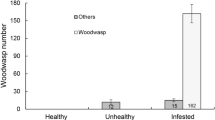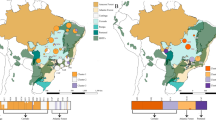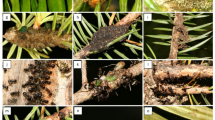Abstract
The genus Sirex (Hymenoptera: Siricidae) consists of 29 species including the Sirex Woodwasp, Sirex noctilio, which is the main insect pest of pine plantations in the Southern Hemisphere including Brazil. In 2023, a species of Sirex similar to S. noctilio was discovered in Southeastern Brazil infesting pine plantations and causing tree mortality of up to 40%. We definitively identified this species as Sirex obesus based on both morphological characters and DNA barcodes. It is a species indigenous to the Southwestern United States and Northern and Central Mexico with little information available regarding its biology and control. This is the first record of S. obesus in Brazil and the first record of the species outside of North America. We document details about S. obesus occurrence in Brazil, describe preliminary damage caused in pine plantations and provide a partial list of natural enemies.
Similar content being viewed by others
Introduction
Woodwasps in the family Siricidae, with 20 known genera and 124 species1, predominantly occur in the Northern Hemisphere (North America, Europe, Northern Africa and Asia) where they are typically considered minor or secondary pests. When accidentally introduced to countries in the Southern Hemisphere where Pinus species have been introduced, the Sirex Woodwasp, Sirex noctilio (Hymenoptera: Siricidae), has become the most significant economic pest of Pinus species causing up to 80% mortality in pine trees2.
In South America several siricid species have been detected since the 1980’s including S. noctilio, Urocerus gigas, Urocerus flavicornis and Tremex fuscicornis. Although the other siricids are not as destructive, since 1988, S. noctilio has spread across Brazil’s main Pinus producing regions with high mortality rates of pine trees in southern Brazil during the 1990’s3,4.
Given the destructive potential of certain woodwasp species and the uncertainty surrounding which combinations of woodwasps and host trees leads to significant mortality, detecting and monitoring new woodwasps is of paramount importance to Brazilian silviculture. Herein, we report the discovery in July of 2023 of another exotic woodwasp in the state of São Paulo, Brazil.
Material and methods
On July 18, 2023, a technical inspection was carried out at the Estação Experimental de Ciências Florestais at ESALQ/USP in Itatinga, São Paulo, to investigate the mortality of several Pinus species and subspecies. Trees were inspected in August of 2023 for damage such as mortality, dripping resin or woodwasp-shaped (round) adult emergence holes in the trunk (Fig. 1). For each pine taxon, three sets of ten trees were examined.
The insect specimens collected at this time were damaged; therefore, adult wasps were reared for identification from wood billets in the laboratory at Botucatu, SP. Specimens were identified morphologically by inspection using the keys in Schiff et al.5 under magnification (Olympus SZX9 dissecting microscope). A total of 32 insects, including 15 females and 17 males, were sent to Dr. Nathan Schiff (USDA Forest Service, Stoneville, MS, USA) for taxonomic confirmation by molecular and morphological characters.
Ten adults were separated for mitochondrial DNA Barcode analysis following the protocol proposed by Schiff et al.5. DNA extraction was performed using the Q-Extract DNA Solution (Neobio) in combination with proteinase K (20 mg/ml). Universal primers targeting the Cytochrome Oxidase Subunit I (COI) gene were employed, following Folmer et al.6. The primers used were: LCO1490 (forward) 5′-GGTCAACAAATCATAAAGATATTGG-3′ and HC02198 (reverse) 5′-TAAACTTCAGGGTGACCAAAAAATCA-3′. The PCR reaction was conducted in a final volume of 25 μl, containing 10X PCR buffer (Invitrogen), 3 mM MgCl₂ (25 mM) (Invitrogen), 0.4 mM dNTPs (25 mM) (Invitrogen), 10 pmol of each primer, 0.5 U of Platinum® Taq DNA Polymerase (5 U/μl) (Invitrogen), and 3 μl of extracted DNA.
The amplification protocol was performed using 20 ng of DNA and consisted of an initial denaturation at 94 °C for 3 min, followed by 40 cycles of denaturation at 94 °C for 1 min, annealing at 55 °C for 1 min, and extension at 72 °C for 1 min. A final extension step was carried out at 72 °C for 7 min. The PCR products were visualized on an ultraviolet light transilluminator (Major Science) using a 1% agarose gel and a 100 bp molecular marker (Norgen). The amplified products were purified using magnetic beads (AMPure Agencourt) and quantified using a NanoDrop spectrophotometer (Thermo Fisher Scientific). The samples were sent to the Central Laboratory of IBTEC, UNESP, Botucatu, São Paulo, Brazil, for Sanger sequencing.
Species were identified by comparing sequences to those in a siricid database5 using Lasergene 15 by DNAStar software. Sequences from both directions were combined into contigs using Seqmanpro, aligned in Megalign using Clustal V and compared to generate a Neighbor-Joining tree based on P2K. The sequences were deposited in Genbank under the accession numbers PP790220, PP794013, PP794015 and PP794016.
Results and discussion
At the first inspections, the causal agent was initially assumed to be S. noctilio, given its established distribution in the state of São Paulo7, and the woodwasp-like damage of the trees (Fig. 1). However, there was cause to expect something unusual since in Brazil, S. noctilio is predominantly associated with loblolly pine, Pinus taeda, and many of the trees attacked were Caribbean species, subspecies and hybrids. The affected Pinus taxa included: Pinus caribaea hondurensis, P. caribaea bahamensis, P. caribaea caribaea, P. maximinoi, P. tecunumanii, and P. taeda.
After morphological examination of undamaged male and female woodwasps (Fig. 2) and DNA barcode analysis the species attacking these non-P. taeda pines was determined to be Sirex obesus Bradley, 1913. This species is native to North America, and found in the Southwestern United States, particularly in New Mexico and Arizona, as well as in Northern Mexico, near the U.S. border5, and in Aguascalientes in the central part of the country8. Sirex obesus females are very similar to those of S. californicus, another North American species to which they are most closely related but can be separated from it by the density of pits on the vertex and gena and the short metatarsomere 2. Males can be separated from closely related species by black antennae and yellowish tinted forewings5. Based on DNA barcodes several samples of the Brazilian species were almost identical to S. obesus from the United States and clearly distant from the next closest species, S. californicus (Fig. 3).
A second woodwasp outbreak was observed on November 28, 2023, at a different ___location approximately 130 km from Itatinga, in Buri, SP. This farm had plantations of the pine hybrids P. caribaea hondurensis x P. elliottii and P. caribaea hondurensis x P. tecunumanii, which are used for resin production. Samples from this second site also were identified as S. obesus based on morphology and DNA barcoding. The combined results of the distribution surveys can be seen in Fig. 4.
It’s not possible to determine whether these two outbreaks are related, as the initial point of S. obesus establishment in Brazil is unknown, making it difficult to track its dispersal. In Brazil, S. obesus has been detected in the state of São Paulo, located in the southeastern region, in plantations across 14 municipalities. There is potential for its expansion to the southern region, where the main Pinus plantations are located.
At this time, damage could only be estimated through some preliminary sampling (Fig. 5). One of the most significantly impacted species was P. caribaea hondurensis with, in the worst cases, an average mortality reaching as high as 43%. In contrast, loblolly pine (P. taeda) was much less impacted, averaging 11% mortality. Unfortunately, the mortality statistics alone do not adequately describe the extent of the damage. In addition to the trees that have already died, 30% of P.c. hondurensis trees are dripping resin, a consequence of woodwasp oviposition. Therefore, the eggs will hatch presumably within the next year, and the woodwasp borers will kill those trees. This would increase total mortality from 43% to approximately 73% (43 + 30 = 73%). Likewise, for P. taeda, the current mortality rate of 11% could rise to 49% as an additional 38% of trees succumb. Following this logic, these areas could experience complete tree mortality within a few years.
As this is the first South American population of a poorly known species, we include some descriptive statistics and biological information. Females of S. obesus (n = 207) collected in Itatinga and Buri have an average length of 20.8 mm (ranging from 12.5 to 31.7 mm) and wingspan of approximately 30.7 mm while males (n = 252) measure 16.6 mm on average (ranging from 12.5 to 26.6 mm) and a wingspan of 26.2 mm.
Females are recognized by their overall dark body coloration, thin and dark hind legs, and a long, developed ovipositor protected by a pair of sheaths. The last abdominal segment contains a triangular structure called a cornus. According to Schiff et al.5 females of S. obesus are very similar to those of S. californicus and can be easily confused. Females of S. obesus have a black body, legs, antennae, and palps with metallic blue reflections (Fig. 2).
Males exhibit considerable variation in body size, characterized by an orange abdomen with a dark dorsal spot extending almost the entire length of the abdomen. Sirex californicus and S. obesus males share significant similarities, but they can be differentiated by the metallic blue spot located between tergites 1–7, on the dorsal region of the abdomen in S. obesus, while males of S. californicus have golden-yellow tergites. The hind legs are enlarged, especially the femur, tibia and basitarsus, and are reddish-brown in color (Fig. 2).
There is scarce information about the biology of S. obesus5,8. Reproduction can be sexual, as occurs in other Sirex species, with a higher proportion of males to females (7:1) for the specimens collected in Buri and Guarei, SP. Preliminary data on the longevity of S. obesus adults in Brazil indicate that females live for approximately 5.7 days, while males have a lifespan of about 7.5 days (n ~ 1600).
After mating, females seek out the trunk of Pinus trees to begin oviposition, very similar to the behavior of females of S. noctilio, leaving resin spots along the trunk of the infested trees (Fig. 1).
The development cycle for S. obesus is unknown, but for many temperate woodwasp species it may take 1–3 years between oviposition and the emergence of adults5. Some species in the Southern Hemisphere may take less than 1 year and preliminary rearing results obtained in Brazil, suggest S. obesus could have 2 or 3 generations per year, based on adult emergence in Pinus logs maintained in cages.
Direct observation in Brazilian plantations included tree mortality, larvae making tunnels in the wood, adult emergence holes in the trunk (Fig. 1), and wood staining caused by wood-staining fungi (not shown).
Woodwasps kill trees by injecting a symbiotic wood decay fungus and a phytotoxic mucus into the tree when laying eggs. The toxin weakens the tree, allowing the fungus to spread, typically killing the tree in as little as 3–4 months after oviposition. Sirex noctilio uses the fungus Amylostereum areolatum whereas S. obesus in North America uses Amylostereum chailletti, a species that has not yet been confirmed in Brazil5,9.
Wood boring insects are often transported to new places in woody packing material which also may harbor natural enemies. To date we have observed two species known to feed on woodwasps emerging from logs infested with S. obesus: Ibalia leucospoides (Hymenoptera: Ibaliidae) and a species of Schlettererius (Hymenoptera: Stephanidae). Although these species by themselves are not known to effectively control woodwasps they could be part of a control program. We are conducting, so far unsuccessfully, surveys for the parasitic nematode, Deladenus siricidicola (Nematoda: Neotylenchidae), that has been used successfully in several Southern Hemisphere countries to control S. noctilio.
There is no information about the entry pathways of S. obesus in Brazil. The main hypothesis is that the pest may have arrived in packaging material (pallets), as technicians from the Ministry of Agriculture have found pallets without the heat treatment seal required for international trade (ISPM #1510) during some inspections (Wilcken, personal information).
Furthermore, if left uncontrolled, the pest may spread to other pine producing regions in Brazil and neighboring countries and cause serious economic impacts. Considering this is a species new to Brazil, studies on the biological characteristics of the insect and its symbiotic fungus are underway. At the same time, control strategies are being studied to contain the spread of the pest.
Data availability
The datasets generated that support the findings of this study are openly available in Genbank repository (https://www.ncbi.nlm.nih.gov/genbank/). Accession numbers: PP790220; PP794015; PP794013; PP794016.
References
Taeger, A. et al. ECatSym: Electronic World Catalog of Symphyta (Insecta, Hymenoptera). Program version 5.0 (19 Dec 2018), data version 40 (23 Sep 2018). – Senckenberg Deutsches Entomologisches Institut (SDEI), Müncheberg. https://sdei.de/ecatsym/. Accessed 26 Mar 2025.
Haugen, D. A. & Hoebeke, E. R. Sirex woodwasp-Sirex noctilio F. (Hymenoptera: Siricidae). Pest Alert. USDA Forest Service, Northeastern Area, State and Private Forestry. NA-PR-07-05 (2005).
Iede, E. T. & Zanetti, R. Ocorrência e recomendações para o manejo de Sirex noctilio Fabricius (Hymenoptera, Siricidae) em plantios de Pinus patula (Pinaceae) em Minas Gerais. Brasil. Rev. Bras. Entomol 51(4), 529–531. https://doi.org/10.1590/S0085-56262007000400023 (2007).
Corley, J. C., Lantschner, M. V., Martínez, A. S., Fischbein, D. & Villacide, J. M. Management of Sirex noctilio populations in exotic pine plantations: Critical issues explaining invasion success and damage levels in South America. J. Pest Sci. 92(1), 131–142. https://doi.org/10.1007/s10340-018-1060-3 (2019).
Schiff, N. M. et al. Siricidae (Hymenoptera: Symphyta: Siricoidea) of the Western Hemisphere. Can. J. Arthropod. Identif. 21, 1–305. https://doi.org/10.3752/cjai.2012.21 (2012).
Folmer, O., Black, M., Hoeh, W., Lutz, R. & Vrijenhoek, R. DNA primers for amplification of mitochondrial cytochrome c oxidase subunit 1 from diverse metazoan invertebrates. Mol. Mar. Biol. Biotechnol. 3, 294–299 (1994).
Wilcken, C. F., Souza, A. R. D., Puretz, B. O. & Camargo, G. F. Detection of pine woodwasp in Pinus taeda in São Paulo State, Brazil. Cienc. Rural 48(2), e20170632. https://doi.org/10.1590/0103-8478cr20170632 (2018).
Sanchez-Martinez, G., Moreno-Rico, O. & Smith, D. R. Primer registro y observaciones biológicas en la avispa de la madera Sirex obesus Bradley en Aguascalientes, México. Agrociencia 50(4), 459–469 (2016).
Morris, E. E., Stock, S. P., Castrillo, L. A., Williams, D. W. & Hajek, A. E. Characterisation of the dimorphic Deladenus beddingi n. sp. and its associated woodwasp and fungus. Nematology 20(10), 939–955. https://doi.org/10.1163/15685411-00003188 (2018).
FAO. International Standard for Phytosanitary Measures (ISPM-15): Regulation for wood packaging material in international trade. 1–24 (2019). https://openknowledge.fao.org/handle/20.500.14283/mb160e
Acknowledgements
To Resinas Brasil and Estação Experimental de Ciências Florestais, ESALQ/USP for allowing us to collect insects in the field and for providing billets infested with insects during this study. The reviewers, who kindly contributed to the manuscript.
Funding
This work was supported by “Conselho Nacional de Desenvolvimento Científico e Tecnológico (CNPq)”, “Coordenação de Aperfeiçoamento de Pessoal de Nível Superior (CAPES-Finance Code 001)” and “Programa Cooperativo sobre Proteção Florestal (PROTEF) do Instituto de Pesquisas e Estudos Florestais (IPEF)”.
Author information
Authors and Affiliations
Contributions
CFW conceived and designed the experiments, performed the experiments, analyzed the data, prepared figures and/or tables, authored or reviewed drafts of the article, and approved the final draft. All authors contributed to the study conception and design. Material preparation, data collection and analysis were performed by CFW, TAM, CHO, VRC, LAB, JAG, SRSW, ELF, NMS, MBC and MFR. The first draft of the manuscript was written by CFW and MFR and all authors commented on previous versions of the manuscript. All authors read and approved the final manuscript.
Corresponding authors
Ethics declarations
Competing interests
The authors declare no competing interests.
Additional information
Publisher’s note
Springer Nature remains neutral with regard to jurisdictional claims in published maps and institutional affiliations.
Rights and permissions
Open Access This article is licensed under a Creative Commons Attribution-NonCommercial-NoDerivatives 4.0 International License, which permits any non-commercial use, sharing, distribution and reproduction in any medium or format, as long as you give appropriate credit to the original author(s) and the source, provide a link to the Creative Commons licence, and indicate if you modified the licensed material. You do not have permission under this licence to share adapted material derived from this article or parts of it. The images or other third party material in this article are included in the article’s Creative Commons licence, unless indicated otherwise in a credit line to the material. If material is not included in the article’s Creative Commons licence and your intended use is not permitted by statutory regulation or exceeds the permitted use, you will need to obtain permission directly from the copyright holder. To view a copy of this licence, visit http://creativecommons.org/licenses/by-nc-nd/4.0/.
About this article
Cite this article
Wilcken, C.F., da Mota, T.A., de Oliveira, C.H. et al. Sirex obesus (Hymenoptera: Siricidae) as invasive pest in pine plantations in Brazil. Sci Rep 15, 22522 (2025). https://doi.org/10.1038/s41598-025-06418-7
Received:
Accepted:
Published:
DOI: https://doi.org/10.1038/s41598-025-06418-7








